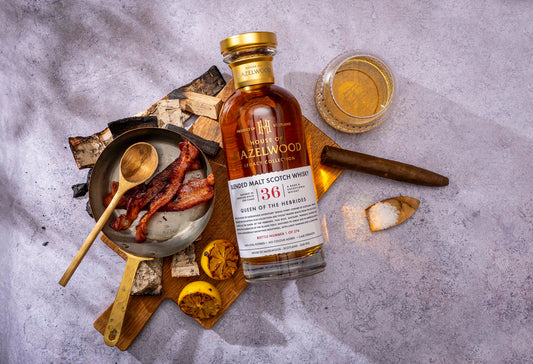Grain versus Malt. A decades-old debate that continues to be the subject of opinion-pieces, dinnertime conversation and endless discussion amongst the whisky community.
While each side has their own ardent supporters, in current times, malt has emerged as the preferred choice – perhaps owing to its growing popularity.
In more recent years, grain has finally begun to regain the recognition it has long deserved and once held, and the argument surrounding the two styles has resurfaced.
Here, we’ll seek to address and dispel some of the myths surrounding this debate and make a case for diversity being the focus of our attention, rather than division.
Grain Versus Malt: What’s the Difference?
Blended malt whisky and blended grain whisky are two types of whisky with distinct differences in production and flavour.
Blended malt whisky is crafted by blending malt whiskies from different distilleries, each made solely from malted barley and distilled in copper pot stills.
In contrast, blended grain whisky is made by blending different grain whiskies from various distilleries, each made from a mixture of malted barley and other grains, of which is distilled in continuous column stills.

Malt Whisky: Rich and Complex
The characteristics associated with a Malt Whisky tend to be pronounced in character – be it smoke, dried fruits, sherry or tropical notes. Peated Malts are often a popular choice – and perhaps one of the outstanding examples of how a Malt can differentiate from a much sweeter grain counterpart.
The peated flavour seen in such a Malt is introduced during the kilning process where peat is burned to dry the barley – imparting phenols from the smoke, influencing the final flavour.
A Trail of Smoke, our 42-year-old Blended Malt Scotch, provides a fine example of this, with age having brought nuances smoke within the final flavour. Married with maritime Malts from other island distilleries, each contributing their own unique profile, this bottle is a classic representation of traditional Blended Malt Scotch.
On the nose, the smoky notes have a savoury quality – evoking imagery of salt-stained cliffsides and lapping waves – before taking on a drier, more herbal aspect.
The flavour opens on the palate, revealing a meandering expression that takes us on a journey across the Scottish Hebrides.
The smoky backbone of peat and woodsmoke provides the foundation for brighter notes of charred fruits which swell in the mouth.
Grain Whisky: Light, Sweet and Smooth
In stark contrast, grain whisky has come to be known for its lighter profile, creamy mouthfeel, and dessert-like qualities.
Take The Lost Estate for example, a Blended Grain Scotch Whisky from the Legacy Collection.
This bottle, blended from the finest grain whiskies produced by now-closed distilleries, has an undoubtedly light, airy feel and a sweetness that lingers enticingly in the mouth.
Having lain in American white oak for 43 years, The Lost Estate is wonderfully inviting and unified on the nose. Complementary notes of pear drop, and sweet mandarin orange are immediately inviting, balanced by notes of bright citrus zest.
On the palate the grain whisky’s creamy sweetness provides an indulgent depth of flavour which emerges alongside crisp notes of citrus and sweet barley sugar.
One would struggle to find a grain whisky that better exemplifies its most celebrated characteristics: creamy, smooth, and bright.
“Gorgeous old grain whisky in all its glory”, Felipe Schreiberg, Forbes.
… Or Maybe Not
Could we simplify the debate of grain vs malt - one is rich and smoky – the other light and smooth?
Well, maybe not.
As ever with whisky, there is far more going on than may seem initially apparent.
On a very simple level, these classifications of flavour may hold a certain degree of truth – with grain whiskies generally lighter, and malt whiskies richer.
However, the selection of cereals is merely one element in the complex process of distilling and maturing a fine Scotch whisky.
There are countless decisions to be made by distillers and blenders alike – from cask selection to the preferred distillation technique.
In this complex environment of experimentation and expression, even a slightly different storage temperature can dramatically affect the final spirit.
With this in mind, we quickly realise that this division of grain vs malt into smooth vs strong is an over-generalisation of the myriad of interactions at play.

Take Sunshine on Speyside, another of our Blended Malt Scotch whiskies, for example.
If we are to follow the most basic of classifications, we could expect the whisky to be deep, rich, and intense. And yet, for Sunshine on Speyside, this couldn’t be further from the truth.
This Blended Malt Scotch, rather, takes on a vivid, fruity character with none of the strength or intensely sherried characteristics so commonly linked to a Speyside Scotch.
Instead, the epitome of its eighties’ origins, Sunshine on Speyside has taken on tropical flavours during the 39 years it has lain in cask.
On the nose, we are greeted by sweet notes of white grape, kiwi, and nostalgic sweet shops of times-gone-by. This theme continues on the palate as waves of charred fruit overlap with notes of zesty citrus and a subtle barbecue smoke.
This whisky’s undoubtedly uplifting character is far from the deeper flavours many have come to expect from a Speyside Blended Malt – and a testament to the diversity of flavour that can be achieved depending on the distiller’s (and subsequently the blender’s) choices.

As further reinforcement of the importance of diversity and variety, we need look no further than The Cask Trials, our 1968 Single Grain Scotch whisky.
Distilled in 1968 and matured for 53 years in a single sherry butt, this Single Grain Scotch showcases the degree of complexity, depth, and richness that grain whiskies can achieve when given time and care – a chameleon profile, akin to that of a well-aged Single Malt.
On the nose, there is a decadent blend of dried apricots, raisins, and dates. While on the palate, this journey into indulgent intensity continues with deeper notes of roasted coffee and Muscovado toffee.
The interaction between Girvan grain and ex-sherry oak cask has resulted in a superbly unified blend – one that is rich in character and supremely indulgent.
With this bottle, we are reminded once more of the shortcomings of the simplistic division of grain vs malt, and, once again, the sheer diversity that can be achieved by this simple spirit.
Grain Versus Malt: Without One, The Other Would Be Lost
Of course, with such contrasting flavour profiles in each category, a skilled blender knows that when combined in the right way, a Blended Scotch Whisky can elevate both components of Malt and Grain.
The sweet and light body of a grain whisky makes the perfect counterpart for tempering the complexity of a malt – and we don’t need to look very far to find the ideal example: The Long Marriage.

A 56-year-old Blended Scotch Whisky from the Charles Gordon collection, The Long Marriage offers a unique blend, having lain undisturbed, matured in a single refill sherry butt for over 50 years.
The resulting liquid promises generous old grain whisky on the nose, accompanied by its malt-counterpart tones of spice and cinnamon on the palate – a cacophony of flavour that would potentially be otherwise without the collaboration between the two styles.
Grain Versus Malt: Diversity over Division
Far from dismissing the debate of grain versus malt, it perhaps serves us best to instead reconsider what we are trying to achieve with this division.
As a simple tool for those new to the world of whisky, these simple divisions certainly offer a starting point for exploration. If lighter, creamier whiskies are your preference, grain whiskies may offer you a better success rate in finding the perfect bottle for new palates. Equally, for those seeking out that a complex character, Blended Malts are an excellent place to dwell.
However, with each style offering its own unique flavour profile and knowledge of the scale of diversity across both categories, we would argue that a strong Scotch collection should celebrate the best of both grain and malt whiskies, and those which are blended together.
The appeal of whisky that captivates so many of its devotees resides in this discovery of flavour – the subtle differences in production that result in radically different experiences, the interplay between cask and spirit, the variety, and the mystery.
Thus, by limiting yourself to either grain or malt, you risk not only depriving yourself of a whole range of flavours and expressions, but also the core element of whisky that makes it so rewarding, its magic.





